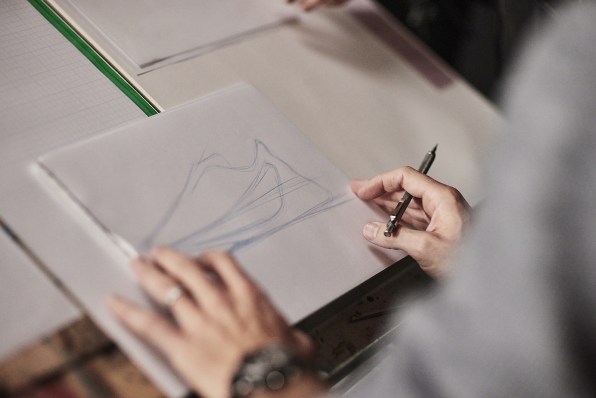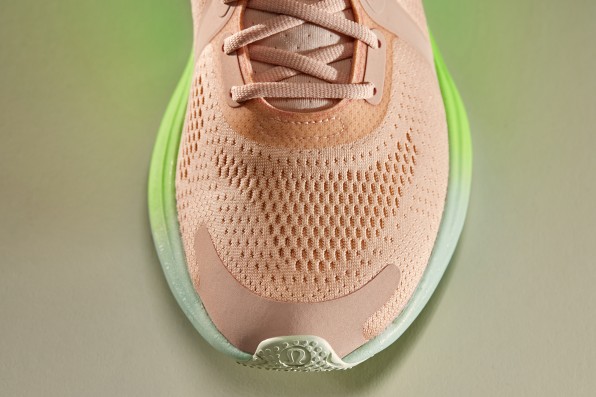In its Vancouver lab, Lululemon tracks the movement of women’s breasts and centers of gravity as they run, jump and stretch to create perfectly fitting sports bras. But four years ago, the brand’s designers realized that this wealth of data could help them create an entirely new product: shoes adapted to the movements of women’s bodies.
Last April, the brand launched its very first shoe, designed for running, and has just launched its second, for cross-training. Both were designed specifically for women. This sets Lululemon apart from most sneaker brands, which often design shoes for male bodies before scaling them down to women’s sizes.
The brand believes that its women-focused design strategy will allow it to create sneakers that are more supportive, more comfortable and perform better than others on the market. And given that each series of shoes sold out within days of their launch, the approach seems to be working.
The original sneaker was a men’s shoe
In the 1830s, a British entrepreneur named John Boyd Dunlop invented a new shoe that bonded canvas to rubber soles, which was more flexible than the leather shoes of the past, creating special shoes for the legend of the tennis Fred Perry. Then, in 1917, Boston-based Converse released a shoe specifically designed for basketball, teaming up with Chuck Taylor to create a shoe that would help him perform better on the court.
In the 1950s and 60s, a wave of sneaker brands emerged, including Puma, Adidas, Reebok, and Nike. They have evolved the sneaker using new materials, such as synthetic foams for cushioning; but like their predecessors, they were tailored to the feet and movements of male athletes. When they first started creating women’s shoes, most simply produced them in smaller sizes and more feminine colors, a strategy that sometimes continues today. “Women’s products are just taken from men’s, shrunken down and with pink or glitter on them,” said Libby DeLana, co-founder and creative director of Mechanica, a creative agency that has worked with sneaker brands like Saucony. Glossy in 2019.
Over the years, efforts have been made to adapt shoes to women’s needs. In 2016, for example, Adidas began using motion-tracking technology to study women’s movement, eventually releasing the Pure Boost sneaker with a higher arch; Puma and Under Armor have just started making running shoes specifically for women. Last year, track and field star Allyson Felix launched her own brand, Saysh, which makes fashionable sneakers tailored for women’s feet. And a new startup, Hilma, is currently designing a women’s performance sneaker, which is expected to launch soon.

From bras to shoes
Lululemon believed it was perfectly positioned to tackle this market. When it launched in 1998, it stood out from other sportswear brands because it exclusively produced products for women. (It didn’t start creating menswear until 2014.) The brand started out with yoga apparel, but quickly expanded into high-impact sports. Like its competitors, it has built a high-tech lab to collect user data. “We do so much R&D specifically for women, especially when it comes to bras and how women feel in them,” says Chantelle Murnaghan, vice president of research at Lululemon. “We are constantly looking to extend these sensory experiences from head to toe. But we were still missing the toe component.
Four years ago, Lululemon decided to start creating shoes. The brand has hired footwear experts, led by George Robusti, the former senior design director for running at Adidas. And rather than just taking existing sneaker prototypes, the team started with a clean slate. “Usually the industry has simply aggregated knowledge and innovations from the past to create new shoes,” says Robusti. “They overlooked the opportunity to design specifically for women. We chose to start from scratch.”
After decades of analyzing women’s bodies in motion and then comparing them to men’s bodies for the launch of menswear in 2014, it was clear to Lululemon researchers that women’s feet are distinct from men’s. . “A lot of our ideas came from so much research into breast movement,” says Murnaghan. “We understand every detail of how women’s breasts move, which has given us a better understanding of their whole body in motion. It is clear that shoes can influence the way the breasts move, influencing the full trajectory of the body.
The team started by studying the shape of women’s feet by making 3D scans. They also worked with biomechanists, neuroscientists and engineers to explore the relationship between the morphology of women’s feet and the rest of their bodies. Using over a million data points, they identified that, on average, women have narrower feet. And compared to men, their heels are proportionally narrower than the front part of their foot. Women can also have higher arches. “All those millimeters of difference makes a huge difference,” says Robusti. “It’s the secret sauce to ensuring high fit and feel.”

So how do they feel?
After creating a few early prototypes, the brand began testing the shoes with hundreds of women, from brand ambassadors to marathon runners to everyday consumers. A runner wore it during a run from Los Angeles to Las Vegas called The Speed Project. In some rounds of reviews, they were sending unmarked versions of their shoe, so they could get objective information.
The goal was to collect quantitative data, but perhaps more importantly, qualitative information. It’s part of Lululemon’s broader design approach, which it calls the “Science of Feeling,” which focuses on the wearer’s subjective experience when wearing a product. “Our unique perspective is that we don’t just create a product to perform well in one activity,” explains Robusti. “We’re more interested in how the product translates in terms of feel and emotion.”
The team continued to tweak the shoe based on feedback, and they knew they were on the right track when runners reported that their sneakers were comfortable enough to run longer without feeling fatigued. “We embarked on a rapid prototyping pace of the shoe architecture, adjusting the foam compounds along the way,” he says. “We joked that what we were testing was the level of smiling at the end of the race.”
In April, Lululemon launched the Blissfeel running shoe; and in August he discontinued the Chargefeel training shoe. Both sold out within days and the brand had to restock quickly. Now Lululemon continues to do R&D to create shoes for other activities. Eventually, it will also be able to start manufacturing shoes for men. But Lululemon’s successful foray into footwear suggests there’s a strong demand for performance sneakers designed specifically for women, paving the way for startups like Saysh and Hilma to enter the market as well.
For Robusti, the key to the brand’s continued success lies in the constant study of the complexity of women’s bodies in motion. “We want the shoes to react to the way women’s bodies naturally move, rather than forcing women to modify their movements based on their shoes,” he says.

